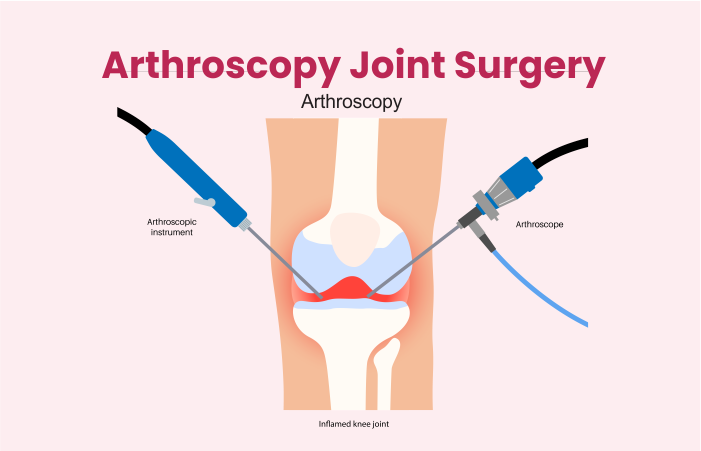Arthroscopic joint surgery in Hyderabad

Arthroscopic joint surgery
Arthroscopic joint surgery is a minimally invasive surgical procedure used to diagnose and treat various joint conditions. This article provides comprehensive information about arthroscopic joint surgery, focusing on arthroscopic knee surgery and arthroscopic shoulder surgery. It includes details about the purpose of the procedure, preparation guidelines, information about the procedure itself, and the potential consequences of delaying arthroscopic joint surgery. Additionally, it highlights the best orthopedic hospital in Hyderabad and the availability of skilled arthroscopy surgeons in the region.

Why is Arthroscopic Joint Surgery Performed?
Arthroscopic joint surgery, such as arthroscopic knee surgery and arthroscopic shoulder surgery, is performed for several reasons:
- Diagnostic purposes: It allows the surgeon to visualize the inside of the joint, assess the extent of injury or damage, and make an accurate diagnosis.
- Treatment of joint conditions: Arthroscopy can be used to treat various joint conditions, including meniscal tears, ligament injuries, cartilage damage, rotator cuff tears, and joint inflammation.
- Joint debridement: The procedure can remove damaged tissues, repair or remove loose fragments, and improve joint function and mobility.
How to Prepare for Arthroscopic Joint Surgery
Preparing for arthroscopic joint surgery involves the following steps:
- Consultation: Schedule a consultation with an orthopedic surgeon specializing in arthroscopic joint surgery at the best orthopedic hospital in Hyderabad.
- Preoperative evaluation: The surgeon may conduct a physical examination, review your medical history, and order imaging tests (such as an MRI or X-ray) to evaluate the joint condition.
- Preoperative instructions: Follow your surgeon’s instructions regarding fasting, medication use, and any necessary lifestyle modifications leading up to the surgery.
- Anesthesia options: Discuss the anesthesia options with your surgeon to determine the most suitable choice for your case.
More About Arthroscopic Joint Surgery:
Arthroscopic joint surgery is a minimally invasive procedure performed using an arthroscope, a thin tube with a camera and surgical instruments. The surgeon makes small incisions near the joint and inserts the arthroscope to visualize the joint structures. The images captured by the camera guide the surgeon in performing necessary repairs or removal of damaged tissues. Compared to open surgery, arthroscopy offers advantages such as smaller incisions, reduced scarring, faster recovery, and less postoperative pain.
Post-surgery, a rehabilitation program involving physical therapy plays a vital role in restoring joint function, improving strength, and facilitating a successful recovery.
Consequences of Delaying Arthroscopic Joint treatment
Delaying arthroscopic joint surgery can have various consequences:
- Increased pain and discomfort: Delaying treatment may result in persistent pain, inflammation, and limited mobility, affecting daily activities and quality of life.
- Progression of the condition: Some joint conditions, such as meniscal tears or rotator cuff tears, can worsen over time if not addressed promptly, leading to further damage and potential complications.
- Functional limitations: Delaying surgery may restrict joint function, making it challenging to perform certain movements or participate in sports and physical activities.
- Development of secondary issues: Untreated joint conditions can lead to secondary problems, such as cartilage damage, joint instability, or muscle atrophy, which may require more extensive treatment in the future.
- Prolonged recovery time: Delaying surgery may lengthen the overall recovery time as the condition may worsen, necessitating additional procedures or longer rehabilitation periods.
Frequently Asked Questions (FAQs)
Arthroscopic joint surgery is a surgical procedure that involves the use of a tiny camera called an arthroscope to visualize and treat problems within a joint. The surgeon makes small incisions, inserts the arthroscope into the joint, and examines the structures using a monitor. Through additional small incisions, specialized instruments are used to repair or remove damaged tissues, repair ligaments, or smooth out rough cartilage surfaces.
Arthroscopic joint surgery can be performed on various joints in the body, including the knee, shoulder, hip, ankle, elbow, and wrist. It is commonly used to address conditions such as torn ligaments, meniscus tears, cartilage damage, joint inflammation, and loose bodies within the joint. The specific joint that requires treatment depends on the individual’s condition and symptoms.
Arthroscopic joint surgery offers several benefits over traditional open surgery. These include smaller incisions, reduced risk of complications, shorter hospital stays, less pain, faster recovery, and minimal scarring. The minimally invasive nature of the procedure allows for quicker return to daily activities and sports, compared to open surgery.
Recovery after arthroscopic joint surgery varies depending on the type of procedure performed and the individual’s overall health. In general, the recovery process involves pain management, physical therapy, and gradually increasing activity levels. The surgeon will provide specific postoperative instructions, including wound care, activity restrictions, and rehabilitation exercises to aid in the recovery process. It is important to follow these instructions to optimize healing and outcomes.
While arthroscopic joint surgery is considered safe, there are potential risks and complications associated with any surgical procedure. These may include infection, bleeding, blood clots, nerve or blood vessel damage, stiffness, limited range of motion, and the possibility of the need for additional surgery. It is crucial to discuss these risks with your surgeon and adhere to pre- and postoperative instructions to minimize the chances of complications.









